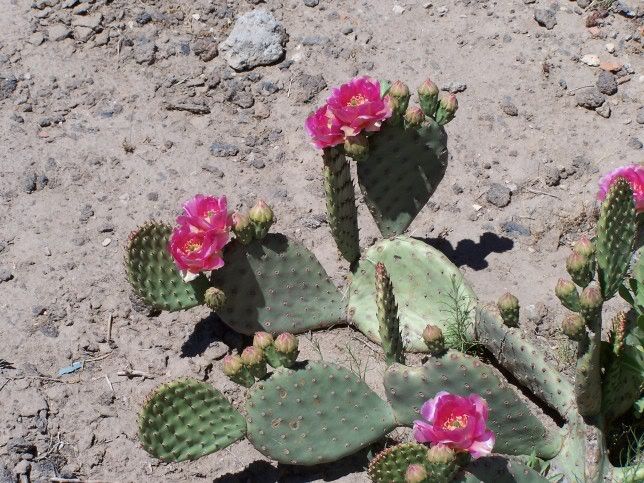Dose anyone else grow Opuntia aurea?
I grow one magenta pink colored clone and one yellow yellow colored clone.
I also have two that seem to be hybrids, they are not as large. One has rose pink flowers, the other never blooms is extremely slow growing (for an Opuntia) and gets very thick, small pads.
Here is the large magenta clone.
I end up trimming it by 1/3 every year to keep it in check.
Here is the large yellow one.
The pads have a hint of gray coloration.
This is the smaller one with rose pink flowers.
This last is the one with small thick pads.
On the mother plant I have see the pads as thick as one inch.
I have never seen the mother plant in bloom.
The owner of it told me it will not bloom for him either.

Comments
Re: Opuntia aurea
Aaron
They sure do like to lie around don't they. Nice to see the pink flowers against the gray pads on your plant.
Re: Opuntia aurea
Lying around is what makes it O. aurea. I grow one, that used to be called O. basilaris var. aurea, that I think has never bloomed and grows one pad every ten years. I have another, that I got from Rod Haenni, that's purple in winter, and purple tinged the rest of the year. This hasn't bloomed either.
But they look nice.
Bob
Re: Opuntia aurea
I find O aurea to be a very reliable bloomer. I have magentas and yellow forms. Very different from basilaris.
Re: Opuntia aurea
Aaron
They sure do like to lie around don't they. Nice to see the pink flowers against the gray pads on your plant.
Thanks I got it from LaMar. That one you have is very bright (top pic) 8)
Re: Opuntia aurea
Aaron
I figured as much? He dose a good job of screening his clones for reliable hardiness.
Re: Opuntia aurea
According to Benson, the taxon he called Opuntia basilaris var. aurea has joints to 10 cm long, 5 cm across, no spines, yellow flowers, and forms "chains" as it grows. Anderson calls this O. aurea.
Var. basilaris has cerise flowers, joints to 17.5cm long , 10 cm across, no spines. Only var. treleasei has spines.
Benson says that "var. aurea" intergrades with O. erinacea var. utahensis (which Anderson calls O. polyacantha var. erinacea); the resulting plants having at least some spines. This would probably account for forms of O. aurea have flowers other than yellow.
Bob
Re: Opuntia aurea
From what I understand O. aurea and O. polyacantha have the same number of chromosomes so hybridize readily. I am sure there are more than just F1 hybrids in the populations. You will see variations in color, spination and pad sizes across the range.
http://www.efloras.org/florataxon.aspx?flora_id=1&taxon_id=242415219




Took some time but I found a pic. :)
